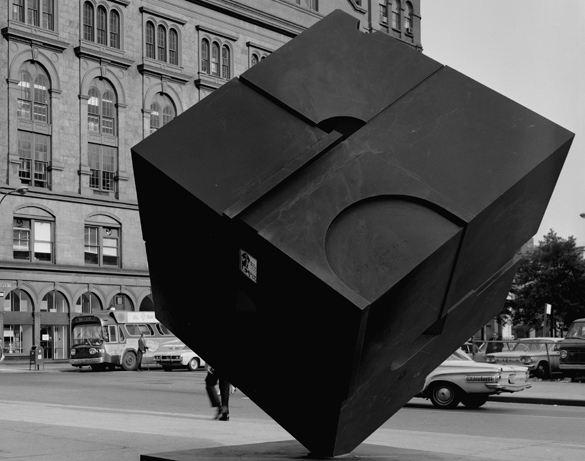My Favorite Things: Alamo (the Cube)

It’s fall, 1967. A one-ton steel cube is dropped by the Lindsay administration into the middle of a grimy traffic island in an increasingly dodgy part of town. Instantly scuffed and plagued by graffiti, the hulking, monochromatic form could have easily been dismissed as a bland mid-century beautification scheme. A stark gift to the people from the faceless bureaucracy of a city teetering on the brink. But instead of being dismissed and ignored, it’s been embraced as a community landmark, and is one of my favorite things.
Public art has a funny way of turning the person on the street into the toughest of critics. What the heck is it? How much of my tax bill went into this? My five-year-old could have made something better (with her eyes closed). In many ways, the critical reaction generated — whether taking place in the privacy of one’s mind or as the captive audience of a chatty taxi driver – is part of the point. The public is engaged and feels an emotional response (positive or negative) to a piece of work, and voilà, you’ve got ‘art’ doing its job.

Monumental modern abstract sculpture, despite being part of the public consciousness for over half a century, can generate some of the most negative reactions. Many works have been plopped down like oversized play things in front of corporate headquarters and on public plazas. Farther downtown, Richard Serra saw his monumental piece, Tilted Arc, removed and destroyed in the late 1980s in part because of the negative public reaction.
Tony Rosenthal’s Alamo sculpture at the intersection of the East Village, Greenwich Village, and NoHo, has instead held out on its little urban island for decades to become one of the most recognizable and beloved public sculptures in the city. Named by Rosenthal’s wife, it was originally installed by the city as part of a temporary public art exhibition called Sculpture in Environment along with 31 other artworks around the city. Almost instantly, the 15 foot-square cube of painted CorTen steel, which could be turned on its axis, clicked with the public. In September 1967, the New York Times noted that the recently installed “Alamo has already become a favorite huddling place for hippies and students of nearby Cooper Union.”

After the temporary exhibit ended, enough goodwill was generated in the local community that it lobbied the city to keep the cube in place (not unlike the way that Washington Square Arch, the London Eye, and the Eiffel Tower, among many other familiar monuments, went from being temporary installations to permanent and beloved fixtures) . An anonymous donor paid the cost to donate the piece to the city.
Though a jarring departure from its nineteenth century neighbors like the DeVinne Press Building, Cooper Union’s Foundation Building, the Village Voice building, and Colonnade Row, the cube and the space around it became a place to meet, interact, and sit and view the city. I’d contend that more “living” has been done around the cube than will ever happen in the recently completed “Sculpture for Living” tower across the street from it. The cube also remains at the center of the upcoming Astor Place pedestrianization plans. Over the years Alamo has been spray-painted, chalked, flyered, crocheted, and even transformed into a Rubik’s cube, but remains resilient in the face of these creative/destructive public re-appropriations.

The sculpture’s minimalist form offers a chance for the public to reinterpret it as they see fit. It’s a place to meet (particularly in the days before second-by-second cell phone location updates). It’s a place to hang out as a youth and compare the new color of your hair, the size of your wallet chain, or the design of your fishnets with your compatriots. Its the hungover memory of spinning a huge dark block after stumbling out of a bar. It’s an underdeveloped piece that only makes its presence known by its monumental size. It’s a sheltered place to read. It’s a sheltered place to text. It’s the kinetic dividing point between East and West. It’s a place to watch and be watched. It’s also one of my favorite things.

One response to “My Favorite Things: Alamo (the Cube)”